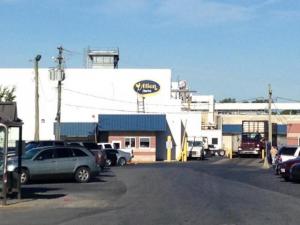Allen Harim cited for air quality violations
Allen Harim's poultry processing plant in Harbeson is again facing citations from state environmental officials, this time for excessive odors considered to be air pollution.
More than 200 complaints about odor, detectable beyond the plant's property near the intersection of routes 5 and 9, were received Aug. 1 through Sept. 12. Officers with the state’s Environmental Crimes Unit confirmed 99 of those complaints and that strong odors were detected beyond the plant’s property on 20 days in that time period, a notice of violation states.
Officials with the state Department of Natural Resources and Environmental Control's Division of Air Quality notified the company, headquartered in Seaford and owned by South Korea-based Harim group, of the violations Nov. 3. The notice shows most complaints have been resolved, noting the issue has caused discomfort to nearby residents.
“We will continue to stay in constant contact with DNREC and work with them to identify any source of odor that may or may not be coming off our property," Allen Harim CEO Joe Moran said in a statement. He said he met with DNREC Secretary David Small last week for a tour of the facility and to discuss operations at the plant.
Earlier this month, state officials slammed Allen Harim with dozens of violations for discharging wastewater that contained high levels of pollutants – concentrations that significantly exceeded permitted levels – from its Harbeson facility into Beaverdam Creek. The creek flows into the Broadkill River, which then empties into the Delaware Bay.
In August and September, around the same time people were calling DNREC to complain about odor emanating from the plant, the facility's wastewater treatment system was inadequately treating pollutants such as ammonia and bacteria.
“For years it seemed like it was just pushed under the table, and they did what they wanted to do. Now there are restrictions they should be abiding by, and I think that they're trying,” said Jeanette Wagner, who has lived across the street from the plant since 1960.
“I would criticize DNREC,” she said. “If they allow it, of course the plant is going to continue to do whatever if they're not going to be fined. As long as they can get away with it, they don't have to rush as far as the improvements.”
From Aug. 31 through Sept. 2, the plant was found to be discharging more than 121 pounds per day of ammonia into the creek, nearly eight times the amount permitted. On Sept. 7-8, the plant discharged wastewater containing 248 enterococcus colonies in a 100 milliliter sample. The permitted level is 113 colonies.
Excess ammonia can cause eutrophication, which encourages algae blooms that can lead to fish kills due to a lack of oxygen. High levels of enterococcus in a waterway signify that bacteria known to cause gastrointestinal issues in humans is present in the water.
Dozens of other violations included in the notice – excess levels of nitrogen, phosphorous, total suspended solids and biochemical oxygen demand – dated back to 2012.
A spokesperson for Allen Harim previously said the company has been made aware of “intermittent spikes in the levels of ammonia” and said they are working with DNREC to resolve the issues. A prepared statement pointed to ongoing efforts to expand and upgrade the plant's wastewater treatment facility, which includes the addition of a water-reuse system. That work is supported in part by more than $11 million in low-interest, state-issued loans.
Allen Harim also is in settlement negotiations with the U.S. Occupational Safety and Health Administration after the federal agency claimed the company failed to provide adequate safety measures to avoid musculoskeletal disorders for workers at the Harbeson plant and discouraged employees from properly reporting symptoms and injuries.
The company was facing about $38,000 in fines for the OSHA violations.
Allen Harim has 30 days to respond to the notice of violation regarding wastewater and 15 days to respond to the air pollution notice. While the notice of violation does not come with a fine, DNREC may pursue additional enforcement action, which could add up to tens of thousands of dollars in penalties.






















































